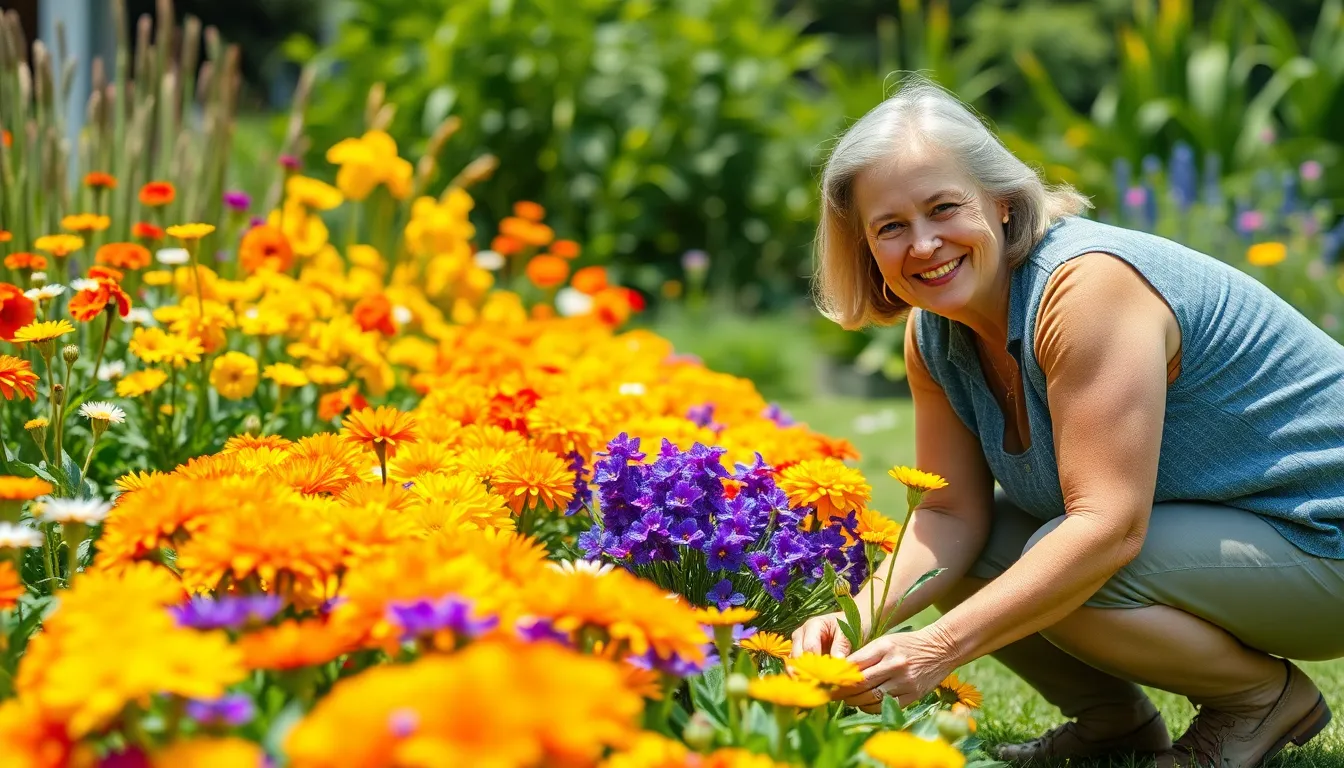A garden isn’t just a patch of dirt with some plants; it’s a canvas waiting for a splash of color. Imagine stepping into a vibrant paradise where every bloom tells a story and each shade sparks joy. Choosing the right color scheme can transform any outdoor space from drab to fab faster than you can say “green thumb.”
Table of Contents
ToggleUnderstanding Garden Color Schemes
A thoughtfully chosen color scheme transforms gardens into captivating spaces. Colors attract attention, create harmony, and define the garden’s theme, influencing how one experiences the outdoors.
The Importance of Color in Gardening
Color serves as a vital element in garden design. It draws visitors in, highlights specific plants, and can unify various garden sections. Bright colors, like yellows and oranges, create energy and enthusiasm. Cool colors, such as blues and purples, evoke tranquility. Sustainability practices often emphasize selecting native plants with vibrant colors that thrive in the local environment. This approach enhances biodiversity while ensuring aesthetic appeal.
How Color Affects Mood and Perception
Colors shape emotions and influence perceptions significantly in gardens. Warm colors, like reds and pinks, inspire excitement and passion. They stimulate energy and create a welcoming atmosphere. On the other hand, cool colors produce a calming effect. Green plants signify life and balance, contributing to overall well-being. Additionally, using contrasting colors captures attention and creates focal points, guiding visitors through the garden experience. The right combinations can lead to heightened enjoyment and relaxation.
Types of Garden Color Schemes

Different color schemes create unique atmospheres in gardens. Each type uses a specific approach to choose plant colors, enhancing both beauty and harmony.
Monochromatic Schemes
Monochromatic schemes focus solely on one color. This approach highlights various shades and tints of that single hue. For example, a garden featuring different shades of blue can create a serene environment. It’s easy to achieve depth by mixing light and dark tones of the same color, which provides visual interest without overwhelming the senses. Gardeners can experiment by adding textures, such as delicate flowers alongside robust foliage, to enhance the monochromatic effect.
Complementary Color Schemes
Complementary color schemes utilize pairs of colors that are opposite each other on the color wheel. For instance, combining bright yellow with deep purple creates striking visual contrast. The strong juxtaposition draws attention, making certain areas of the garden focal points. This scheme enhances vibrant flowers and lush greenery, creating an energetic atmosphere. Gardeners might plant a mix of both colors in close proximity, allowing each to accentuate the other beautifully.
Analogous Color Schemes
Analogous color schemes blend colors that are next to each other on the color wheel. Shades such as red, orange, and yellow work well together, providing a harmonious and cohesive look. This type of scheme cultivates a sense of unity in the garden, allowing plants to complement rather than compete with each other. Gardeners can maximize this effect by grouping plants of similar colors in clusters, ensuring an inviting and visually appealing space.
Choosing the Right Color for Your Garden
Selecting the right color can significantly enhance a garden’s appeal. Several factors influence this decision, ensuring a beautifully cohesive space.
Factors to Consider
Consider the garden’s overall theme before choosing colors. Think about the existing elements, including architectural features and nearby landscapes. Match colors with the intended mood; warm tones energize while cool shades soothe. Evaluate sunlight exposure, as it affects how colors appear in different light conditions. Additionally, plant selection influences color compatibility. Lastly, local climate may determine which plants thrive, impacting the color scheme.
Seasonal Color Considerations
Seasonal changes affect how colors appear in the garden. For spring, vibrant blossoms like tulips and daffodils provide lively pops of color. Summer gardens often flourish with sunflowers and marigolds, radiating warmth and joy. Autumn introduces rich hues like golden yellows and deep burgundies from chrysanthemums and asters. Winter gardens can showcase evergreen plants and ornamental features that provide structure and subtle color. Planning for seasonal transitions enhances a garden’s visual interest throughout the year.
Examples of Popular Garden Color Schemes
Various garden color schemes create distinct atmospheres, enhancing the overall appeal. Each scheme contributes uniquely to the garden’s design.
Pastel Gardens
Pastel gardens evoke soft elegance. Often incorporating colors like pale pinks, light blues, and soft yellows, these gardens provide a gentle, serene ambiance. Annuals such as pansies and perennials like peonies thrive in this palette. Layering different shades enhances depth and visual interest. This approach draws attention without overwhelming visitors. Subtle contrasts between flowers and foliage maintain harmony, fostering a relaxing environment. Easy-to-maintain pastel gardens suit those seeking a tranquil oasis.
Bold and Vibrant Gardens
Bold and vibrant gardens ignite energy and excitement. Bright reds, yellows, and purples dominate this palette, creating striking focal points. Flowers like sunflowers and zinnias stand out against lush greenery. Eye-catching contrasts invite exploration and engagement with the space. Mixing diverse species enhances the garden’s dynamism and visual appeal. This color scheme showcases the gardener’s personality, making a bold statement. Fun and playful combinations captivate visitors, transforming outdoor spaces into lively retreats.
A well-planned color scheme can truly elevate any garden. By thoughtfully selecting colors that resonate with the desired atmosphere gardeners can create stunning outdoor spaces that invite exploration and relaxation. The interplay of warm and cool tones not only enhances visual appeal but also influences the mood of those who visit.
Whether opting for a monochromatic palette or a vibrant mix of complementary colors each choice shapes the garden’s identity. Seasonal considerations further enrich the experience ensuring that the garden remains captivating throughout the year. Ultimately the right colors can transform a simple garden into a vibrant sanctuary that reflects the gardener’s vision and passion.



